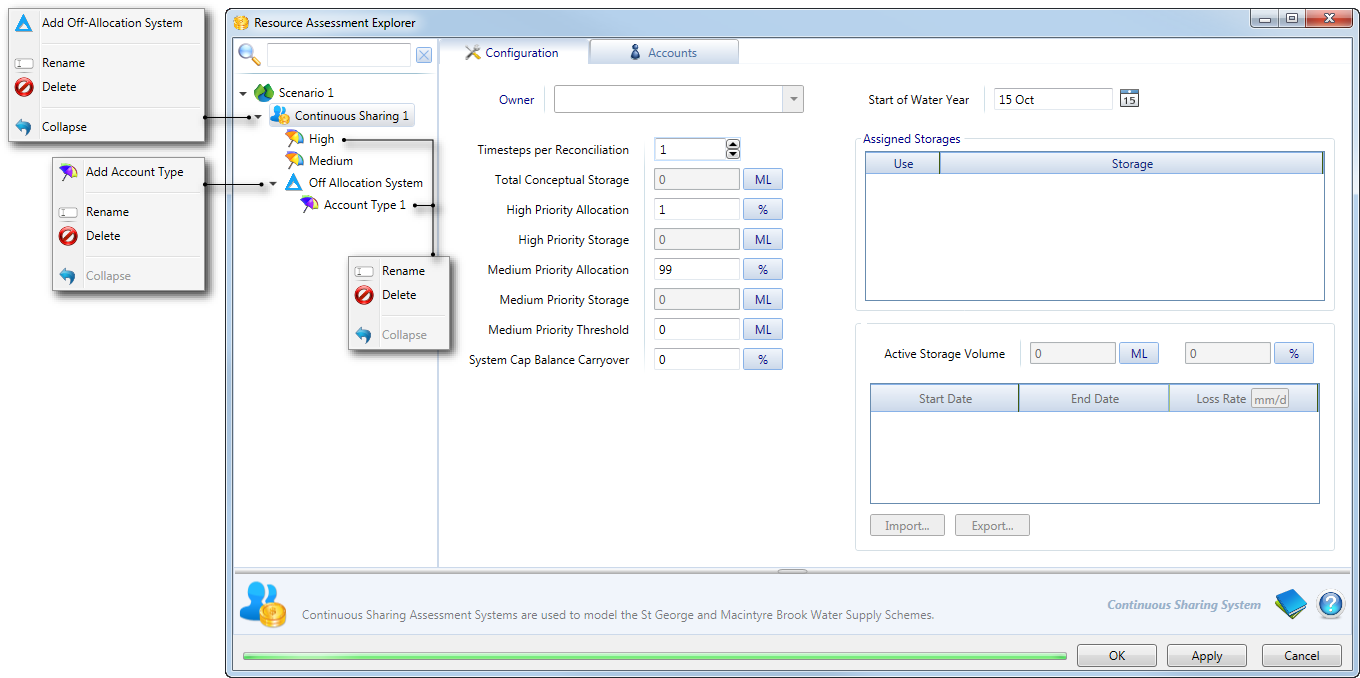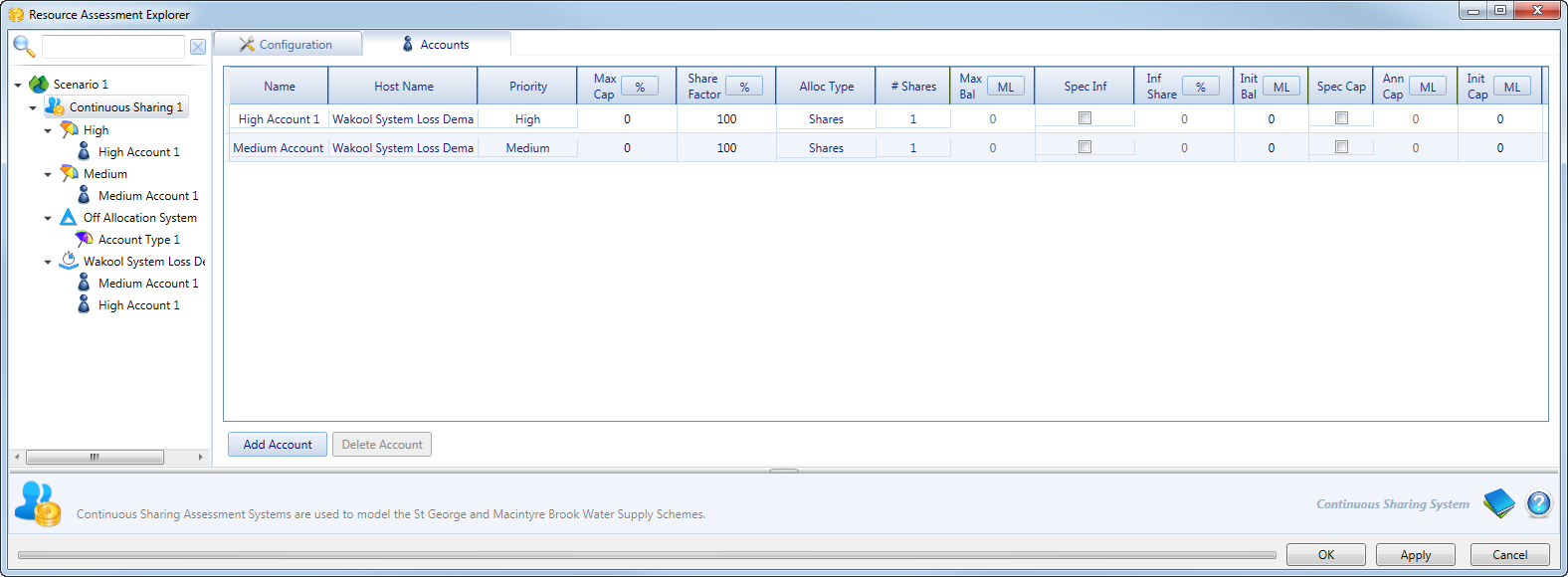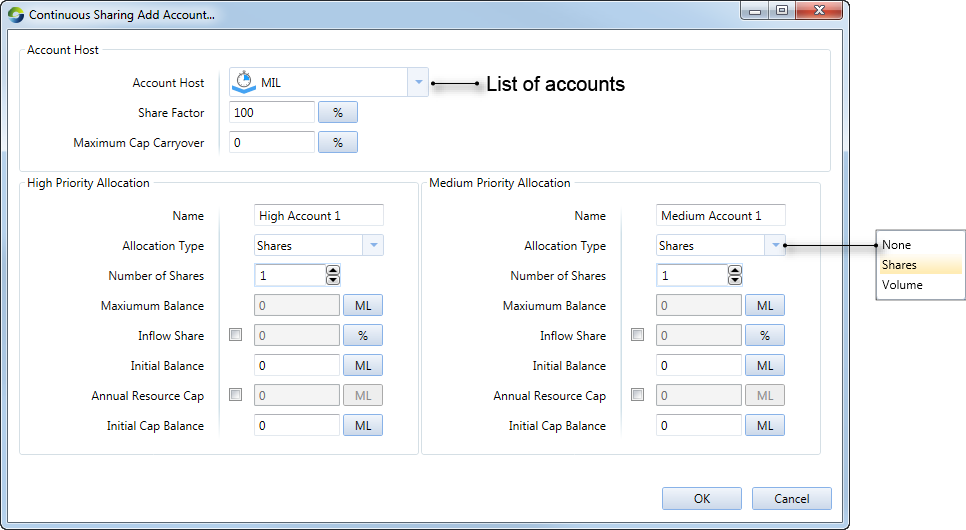Note: This is documentation for version 4.11 of Source. For a different version of Source, select the relevant space by using the Spaces menu in the toolbar above
Continuous sharing
A continuous sharing resource assessment system is one in which the behaviour of a water user has as little effect as possible on other water users within that system. For detailed information about continuous sharing, refer to the Source Scientific Reference Guide.
To enable continuous sharing in Source (as shown in Figure 1 here):
- Choose Edit » Resource Assessment... to open the Resource Assessment Explorer; and
- Right-click the scenario for which you wish to enable resource assessment and choose Add Continuous Sharing from the contextual menu.
To rename the system, right click and choose Rename. Then, enter the new name in the editable box.
System Configuration
To configure a continuous sharing system, start by selecting the owner whose share is described by this system from the Owner pop-up menu (Figure 1) and define the start of the owner’s water year. The owner may be any one of the defined owners in the physical system being modelled. The other owners are assumed to use separate allocation systems, with all calculations occurring independently. Table 1 explains the attributes that must be configured.
Figure 1. Continuous sharing, configuration
| Attribute | Details |
|---|---|
| Timesteps per Reconciliation | The sharing of various system losses is based on long term averages. Over time, discrepancies will emerge which must be reconciled. You can control the frequency with which reconciliations occur using this field. The default is one time-step. Shortfalls identified during a reconciliation are treated as storage losses, gains as inflows. Losses and gains are shared based on account share sizes, but ignore account priorities. The reconciliation process also resolves situations such as when multiple resource assessment systems draw upon the same water (whether such a configuration is accidental or deliberate). |
| Total Conceptual Storage | As each storage is selected in the Assigned Storages list, the owner’s share in that storage is added to this field, which is the sum of the active capacity for this owner of all of the assigned storages in the resource allocation system. You cannot edit this value directly. |
| High Priority Allocation | By default, 100% of all allocations are considered to be high priority but you can designate a lesser proportion by adjusting this field. The related fields of High Priority Storage, Medium Priority Allocation and Medium Priority Storage adjust dynamically in response. |
| Medium Priority Threshold | You can adjust this field to determine how inflows are assigned to accounts. It behaves as follows:
The default value is zero, which means that inflows will be assigned to both high priority and medium priority accounts at all storage volumes. |
| System Cap Balance Carryover | This specifies the maximum proportion of the owner’s annual resource cap that the system can carry over into the next water year. |
Next, select each storage that should participate in the continuous sharing system in the Assigned Storages list by selecting the checkbox next to the appropriate storage/s. Note that a storage can be removed from the Assigned Storages by unchecking the checkbox next to the storage name.
NOTE: Need to manually set the inactive storage volume for the assigned storages so that Source can calculate the active volume available for accounts.
Finally, you can define the loss characteristics of each storage in millimetres per day between one or more start- and end-date pairs within the water year. You can also import loss characteristics from a .CSV file formatted as shown in Table 2.
Table 2. Continuous Sharing (Storage loss rate, data file format)
Row | Column (comma-separated) | ||
|---|---|---|---|
1 | 2 | 3 | |
1 | StartDate | EndDate | Rate |
2..n | start | end | flux |
Where: start is the first day of each year represented as dd-mmm (eg "01-Jan") on which flux begins
end is the last day of each year represented as dd-mmm (eg "01-Jan") when flux ends.
flux is the loss rate in millimetres per day for the recurrent period defined by start through end
Adding Accounts
To add accounts to a continuous sharing resource assessment system, switch to the Accounts tab (Figure 2) and click Add Account to open the Continuous Sharing Add Account... dialog (Figure 3). The nodes which appear in the Account Host list on the left hand side of Figure 3 are Water User nodes, otherwise known collectively as demand nodes. Select one of the nodes in this list and click OK. Repeat this process to add additional accounts to the list. Note that accounts can be configured in this window (Continuous Sharing Add Account…) before closing or in the Accounts tab once they have been added (this is explained further below).
By default, an account of each type (i.e. a high priority and medium priority allocation account) is added for each water user, although only one of the accounts is required to have a maximum account balance greater than zero. These accounts for the demand node exist as a pair; that is, you cannot delete just one of them. If a demand node has access to only one type of allocation, the other allocation must be set to zero Shares or zero Maximum Account Balance (depending on the Allocation Type – explained further below). Note that where the High Priority Allocation is 100% (Figure 2), the medium priority account will remain unused no matter how it in configured.
You can delete an account-pair by selecting either of its members and clicking Delete Accounts. As mentioned above, these accounts exist only as a pair, so this will delete both the high and medium priority allocation accounts.
Figure 2. Continuous sharing, Accounts
Figure 3. Continuous sharing (Add accounts)
Account configuration
You can configure individual accounts by manipulating the controls shown in Figure 2 or Figure 3. Fields in grey cannot be adjusted. In Figure 3 they fall into two categories:
- Values that are set by reference to other values. The Maximum Balance value is an example (when the Share Allocation Type is selected); or
- Fields that must first be enabled explicitly. For example, you must check the Annual Resource Cap checkbox before you can specify the cap.
If configuring the accounts in the Accounts tab, there are additional fields which cannot be adjusted. In total there are three categories of fields which cannot be adjusted in this tab (two of which are the same as mentioned above):
- Values that are inherited from the Add Account step and which are included for reference. Examples include the Name, Host Nameand Priority fields;
- Values that are set by reference to other values. The Maximum Balance column is an example (when the Share Allocation Type is selected); or
- Fields that must first be enabled explicitly. For example, you must check the Specify Cap checkbox before you can specify an Annual Resource Cap.
Table 3 explains the account attributes that must be configured.
Table 3. Continuous Sharing, Account parameters
| Attribute | Details |
|---|---|
| Maximum Cap Carryover (Max Cap) | This specifies the maximum proportion of the annual resource cap that the individual account can carry over into the next water year. Note, that the carryover may also be limited by the System Cap Balance Carryover if the total system resource carryover is too high for the water year. |
| Share Factor | Share Factor defines the relationship between orders and the amount that must be released in response to those orders, having regard to losses and gains during transmission:
Accounts with a lower share factor are allocated a larger share of the storage to account for the transmission losses they incur.All share factors at a given priority level within a continuous sharing system are interrelated as follows: |
| Allocation Type (Alloc Type) | Water can be allocated to accounts by Shares or Volume – this is specified in the Allocation Type dropdown list. |
| Number of Shares (# Shares) | If the Shares Allocation Type is selected, this is the number of shares of the conceptual storage allocated to the account. The high and medium priority portions of the storage will be divided based on the number of shares for all high and medium priority account respectively. Once all accounts are configured, the Maximum Balance (which is greyed out) will auto-update to reflect the volume in the storage which is associated with the account. This volume is based on the number of shares for that account and the number of other shares at the same priority level. Note that accounts with a Maximum Balance specified by the user will be allocated first, following that, the remaining active storage capacity will be divided based on the Number of Shares. |
| Maximum Balance (Max Bal) | This field specifies the maximum volume of water that an account holder can store. If the Shares Allocation Type is selected, this value will be automatically calculated. If the Volume Allocation Type is selected, this balance should be configured by the user. The sum of all account maximum balances is equal to the Total Conceptual Storage. |
| Inflow Share (Spec Inf and Inf Share) | The share of inflow to each account is calculated automatically based on the proportion of the active storage capacity allocated to the account (i.e. the Maximum Balance relative to the Conceptual Storage). The share of inflow can be configured manually instead by enabling the Inflow Share check-box and entering an inflow share percentage. Note, that water will be shared between accounts with a user specified inflow share first. The proportion of water remaining will be shared between accounts with automatically calculated inflow shares. |
| Initial Balance (Init Bal) | This is the account balance volume at the start of the simulation. |
| Annual Resource Cap (Spec Cap and Ann Cap) | This cap will limit the annual (water year) volume diverted by the associated account. The maximum cap can be specified for an account by enabling the Annual Resource Cap check-box and entering a volumetric limit (ML). |
| Initial Cap (Init Cap) | This is the account cap volume at the start of the simulation. |



